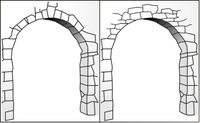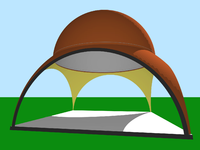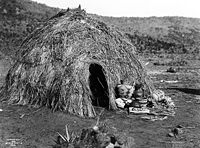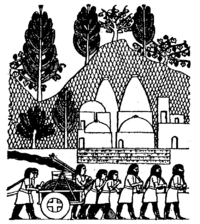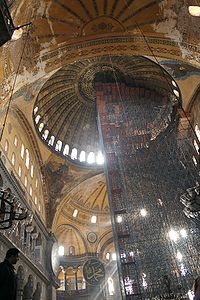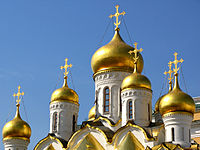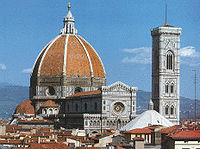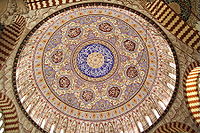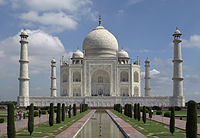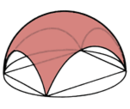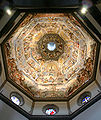- Dome
-
For other uses, see Dome (disambiguation)."Domal" redirects here. For "domal consonants", see Retroflex consonant.
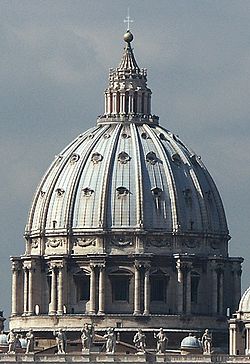 Dome of St. Peter's Basilica in Rome crowned by a cupola. Designed primarily by Michelangelo, the dome was not completed until 1590
Dome of St. Peter's Basilica in Rome crowned by a cupola. Designed primarily by Michelangelo, the dome was not completed until 1590
A dome is a structural element of architecture that resembles the hollow upper half of a sphere. Dome structures made of various materials have a long architectural lineage extending into prehistory.
Corbel domes and true domes have been found in the ancient Middle East in modest buildings and tombs. The construction of the first technically advanced true domes in Europe began in the Roman Architectural Revolution,[1] when they were frequently used by the Romans to shape large interior spaces of temples and public buildings, such as the Pantheon. This tradition continued unabated after the adoption of Christianity in the Byzantine (East Roman) religious and secular architecture, culminating in the revolutionary pendentive dome of the 6th century church Hagia Sophia. Squinches, the technique of making a transition from a square shaped room to a circular dome, was most likely invented by the ancient Persians. The Sassanid Empire initiated the construction of the first large-scale domes in Persia, with such royal buildings as the Palace of Ardashir, Sarvestan and Ghal'eh Dokhtar. With the Muslim conquest of the Sassanid Empire, the Persian architectural style became a major influence on Muslim societies. Indeed the use of domes as a feature of Islamic architecture has gotten its roots from Persia (see gonbad, gongbei).
An original tradition of using multiple domes was developed in the church architecture in Russia, which had adopted Orthodox Christianity from Byzantium. Russian domes are often gilded or brightly painted, and typically have a carcass and an outer shell made of wood or metal. The onion dome became another distinctive feature in the Russian architecture, often in combination with the tented roof.
Domes in Western Europe became popular again during the Renaissance period, reaching a zenith in popularity during the early 18th century Baroque period. Reminiscent of the Roman senate, during the 19th century they became a feature of grand civic architecture. As a domestic feature the dome is less common, tending only to be a feature of the grandest houses and palaces during the Baroque period.
Construction of domes in the Muslim world reached its peak during the 16th – 18th centuries, when the Ottoman, Safavid and Mughal Empires, ruling an area of the World compromising North Africa, the Middle East and South- and Central Asia, applied lofty domes to their religious buildings to create a sense of heavenly transcendence. The Sultan Ahmed Mosque, the Shah Mosque and the Badshahi Mosque are primary examples of this style of architecture.
Many domes, particularly those from the Renaissance and Baroque periods of architecture, are crowned by a lantern or cupola, a Medieval innovation which not only serves to admit light and vent air, but gives an extra dimension to the decorated interior of the dome.
Contents
Characteristics
A dome can be thought of as an arch which has been rotated around its central vertical axis. Thus domes, like arches, have a great deal of structural strength when properly built and can span large open spaces without interior supports. Corbel domes achieve their shape by extending each horizontal layer of stones inward slightly farther than the previous, lower, one until they meet at the top. These are sometimes called false domes. True, or real, domes are formed with increasingly inward-angled layers of voussoirs which have ultimately turned 90 degrees from the base of the dome to the top.
When the base of the dome does not match the plan of the supporting walls beneath it (for example, a circular dome on a square bay), techniques are employed to transition between the two. The simplest technique is to use diagonal lintels across the corners of the walls to create an octagonal base. Another is to use arches called squinchs to span the corners, which can support more weight. The invention of pendentives superseded the squinch technique.[2] Pendentives are triangular sections of a sphere used to transition from the flat surfaces of supporting walls to the round base of a dome.
Domes can be divided into two kinds: simple and compound, depending on the use of pendentives.[3] In the case of the simple dome, the pendentives are part of the same sphere as the dome itself; however, such domes are rare.[4] In the case of the more common compound dome, the pendentives are part of the surface of a larger sphere below that of the dome itself and form a circular base for either the dome or a drum section.[3]
Drums, also called tholobates or tambours, are cylindrical or polygonal walls supporting a dome which may contain windows.
Domes have been constructed from a wide variety of building materials over the centuries: from mud to stone, wood, brick, concrete, metal, glass and plastic.
History
Early history and primitive domes
Cultures from pre-history to modern times constructed domed dwellings using local materials. Although it is not known when the first dome was created, sporadic examples of early domed structures have been discovered.
The earliest discovered may be four small dwellings made of Mammoth tusks and bones. The first was found by a farmer in Mezhirich, Ukraine, in 1965 while he was digging in his cellar and archaeologists unearthed three more.[5] They date from 19,280 - 11,700 BC.[6]
In modern times, the creation of relatively simple dome-like structures has been documented among various indigenous peoples around the world. The Wigwam was made by Native Americans using arched branches or poles covered with grass or hides. The Efé people of central Africa construct similar structures, using leaves as shingles.[7] Another example is the Igloo, a shelter built from blocks of compact snow and used by the Inuit people, among others. The Himba people of Namibia construct "desert igloos" of wattle and daub for use as temporary shelters at seasonal cattle camps, and as permanent homes by the poor.[8]
The historical development from structures like these to more sophisticated domes is not well documented. That the dome was known to early Mesopotamia may explain the existence of domes in both China and the West in the first millennium BC.[9] Another explanation, however, is that the use of the dome shape in construction did not have a single point of origin and was common in virtually all cultures long before domes were constructed with enduring materials.[10]
The recent discoveries of seal impressions in the ancient site of Chogha Mish (c. 6800 to 3000 BC), located in the Susiana plains of Iran, show the extensive use of dome structures in mud-brick and adobe buildings.[11][12] Other examples of mud-brick buildings, which also seemed to employ the "true" dome technique have been excavated at Tell Arpachiyah, a Mesopotamian site of the Halaf (c. 6100 to 5400 BC) and Ubaid (ca. 5300 to 4000 BC) cultures.[13] Excavations at Tell al-Rimah have revealed brick domical vaults from about 2000 BC.[14] At the Sumerian Royal Cemetery of Ur, a "complete rubble dome built over a timber centring" was found among the chambers of the tombs for Meskalamdug and Puabi, dating to around 2500 BC.[15] Set in mud mortar, it was a "true dome with pendentives rounding off the angles of the square chamber." Other small domes can be inferred from the remaining ground plans, such as one in the courtyard of Ur-Nammu's ziggurat, and in later shrines and temples of the 14th century BC.[16]
Corbelled beehive domes were used as granaries in Ancient Egypt from the first dynasty, in mastabas of the Old Kingdom, as pressure-relieving devices in private brick pyramids of the New Kingdom, and as kilns and cellars. Examples have been found in brick and in stone.[17]
Ancient tombs have been found from Oman to Portugal with stone corbel domes. The "Hafeet graves", also called "Mezyat graves", were structures built above ground, dating to the Bronze Age period between 3200 and 2700 BC in an area straddling the borders between Oman, UAE, and Bahrain.[18][19] Similar above-ground tombs made of corbelled stone domes have been found in the fourth cataract region of Nubia with dates beginning in the second millennium BC.[20] Examples on the Mediterranean island of Sardinia have been dated to 2500 BC. The so-called Treasury of Atreus, a large Mycenaean tomb covered with a mound of earth, dates to around 1330 BC.[21] However, small corbel domes functioning as dwellings for poorer people appear to have remained the norm throughout the ancient Near East until the introduction of the monumental dome in the Roman period.[22]
A Neo-Assyrian bas-relief from Kuyunjik depicts domed buildings, although remains of such a structure in that ancient city have yet to be identified, perhaps due to the impermanent nature of sun-dried mudbrick construction.[10][23] However, because the relief depicts the Assyrian overland transport of a carved stone statue, the background buildings most likely refer to a foreign village, such as those at the foothills of the Lebanese mountains. The relief dates to the 8th century BC, while the use of domical structures in the Syrian region may go back as far as the fourth millennium BC.[10]
Wooden domes were evidently used in Etruria on the Italian peninsula from archaic times. Reproductions were preserved as rock-cut Etruscan tombs produced until the Roman Imperial period, and paintings at Pompeii show examples of them in the third style and later.[24] Wooden domes may also have been used in ancient Greece, over buildings such as the Tholos of Epidaurus, which is typically depicted with a conical roof.[10] Evidence for such wooden domes over round buildings in Ancient Greece, if they existed, has not survived and the issue is much debated.[24]
The earliest evidence of a Hellenistic dome is at the North Baths of Morgantina in Sicily, dated to the mid third century BC. The dome measured 5.75 meters in diameter over the circular hot room of the baths. It was made of terracotta tubes partially inserted into each other and arranged in parallel arches, which were then completely covered with mortar. It is also the earliest known example of this technique of tubular vault construction. A Hellenistic bathing complex in nearby Syracuse may also have used domes like these to cover its circular rooms. Another dome with the same parallel arch construction but more refined technique has been identified in the tepidarium at a Roman era bathing complex in Cabrera del Mar, Spain, and dated to the middle of the second century BC.[25]
Roman and Byzantine domes
See also: List of Roman domes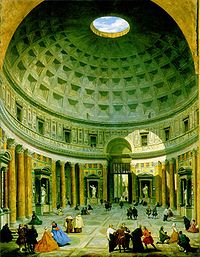 Painting by Giovanni Paolo Pannini of the Pantheon in Rome, Italy, after its conversion to a church.
Painting by Giovanni Paolo Pannini of the Pantheon in Rome, Italy, after its conversion to a church.
Roman domes of the pagan period are essentially found in three environments: baths, villas and palaces, and tombs. Oculi are common features.[24] The Romans also used semi-domes, half a dome "cut" vertically, in niches and the exedras of basilicas.
The octagonal Tower of the Winds in Athens, built by Antigonus of Cyrrhestus, has a flat, monolithic, stone dome. Varro's book on agriculture, written about the same time, describes an aviary with a wooden dome decorated with the eight winds which is compared by analogy to the eight winds depicted on the Tower of the Winds. This aviary with its wooden dome may represent a fully developed type. Wooden domes in general would have allowed for very wide spans. Their earlier use may have inspired the development and introduction of large stone domes of previously unprecedented size.[24] Complex wooden forms were also necessary for centering and support, the construction of which seems to have eventually become more efficient and standardized.[26]
Roman baths played a leading role in the development of domed construction in general, and monumental domes in particular. Modest domes in baths dating from the 2nd and 1st centuries BC are seen in Pompeii.[24] Domes were particularly well suited to the hot rooms of baths, which were circular in plan to facilitate even heating from the walls. However, the extensive use of domes did not occur before the 1st century AD.[26]
The first known large Roman dome is the so-called "Temple of Mercury" in Baiae, a concrete bath hall dating from the age of Augustus (27 BC - AD 14). There are five openings in the dome: a circular oculus and four square skylights.[24] The dome has a span of 21.5 meters and is the largest known dome to have been built before that of the Pantheon.[27] It is also the earliest preserved concrete dome.[26]
The mortar and aggregate of Roman concrete was built up in horizontal layers laid by hand against wooden form-work, rather than poured into a mold as concrete is today, with the thickness of the layers determined by the length of the workday. Roman concrete domes were thus built similarly to the earlier corbel domes of the Mediterranean region, although they have different structural characteristics.[28] The dry concrete mixtures used by the Romans were compacted with rams to eliminate voids, and added animal blood acted as a water reducer.[29]
While there are earlier examples in the Republican period and early Imperial period, the growth of domed construction increases under Emperor Nero, the Flavians, and during the 2nd century AD. The opulent palace architecture of the Emperor Nero (54-68 AD) marks an important development.[24] There is evidence of a dome in his Domus Transitoria at the intersection of two corridors, resting on four large piers, which may have had an oculus at the center. In Nero's Domus Aurea, or "Golden House", the walls of a large octagonal room transition to an octagonal domical vault, which then transitions to a dome with an oculus.[30] This octagonal and semicircular dome is made of concrete and the oculus is made of brick. The radial walls of the surrounding rooms buttress the dome, allowing the octagonal walls directly beneath it to contain large openings under flat arches and for the room itself to be unusually well-lit.[28] Another dome, made of wood, is reported in contemporary sources to have covered a dining hall in the palace, and may have been fitted such that perfume might spray from the ceiling.[24] The dome perpetually rotated on its base in imitation of the sky.[30] The expensive and lavish decoration of the palace caused such scandal that it was demolished soon after Nero's death and public buildings such as the Baths of Titus and the Colosseum were built in its place.
The most famous and best preserved Roman dome - and the largest - is that of the Pantheon, a temple in Rome built by Emperor Hadrian as part of the Baths of Agrippa.[24] Dating from the 2nd century, it is an unreinforced concrete dome 43.4 meters wide resting on a circular wall, or rotunda, 6 meters thick. This rotunda, made of brick-faced concrete, contains a large number of relieving arches and is not solid. Seven interior niches and the entrance way divide the wall structurally into eight virtually independent piers. These openings and additional voids account for a quarter of the rotunda wall's volume. The only opening in the dome is the brick-lined oculus at the top, nine meters in diameter, which provides light and ventilation for the interior. The shallow coffering in the dome accounts for a less than five percent reduction in the dome's mass, and is mostly decorative. The aggregate material hand-placed in the concrete is heaviest at the base of the dome and changes to lighter materials as the height increases, dramatically reducing the stresses in the finished structure. In fact, many commentators cite the Pantheon as an example of the revolutionary possibilities for monolithic architecture provided by the use of Roman pozzolana concrete. However, vertical cracks seem to have developed very early, such that in practice the dome acts as an array of arches with a common keystone, rather than as a single unit. The exterior step-rings used to compress the "haunches" of the dome, which would not be necessary if the dome acted as a monolithic structure, may be an acknowledgement of this by the builders themselves. Such buttressing was common in Roman arch construction.[27] It remained the largest dome in the world for more than a millennium and is still the world's largest unreinforced concrete dome.[31]
Segmental domes, made of radially concave wedges or of alternating concave and flat wedges, also appear under Hadrian in the 2nd century and most preserved examples of this style date from this period. Hadrian's Villa has examples at the Piazza D'Oro and in the semidome of the Serapeum. Recorded details of the decoration of the segmental dome at the Piazza D'Oro suggests it was made to evoke a billowing tent, perhaps in imitation of the canopies used by Hellenistic kings. Other examples exist at the Hadrianic baths of Otricoli and the so-called "Temple of Venus" at Baiae. This style of dome required complex centering and radially-oriented formwork to create its tight curves.[26]
In the 3rd century, Imperial mausolea began to be built as domed rotundas rather than tumulus structures or other types, following similar monuments by private citizens. Pagan and Christian domed mausolea from this time can be differentiated in that the structures of the buildings also reflect their religious functions. The pagan buildings are typically two story, dimly lit, free-standing structures with a lower crypt area for the remains and an upper area for devotional sacrifice. Christian domed mausolea contain a single well-lit space and are usually attached to a church.[32] Examples from the 3rd century are the brick domes of the Mausoleum of Galerius, the Mausoleum of Diocletian, and the mausoleum at Tor de' Schiavi.[33]
In the 4th century, Roman domes proliferated due to changes in the way domes were constructed, including advances in centering techniques and the use of brick ribbing. The so-called "Temple of Minerva Medica", for example, used brick ribs along with step-rings and lightweight pumice aggregate concrete to form a decagonal dome.[26] The material of choice in construction gradually transitioned during the 4th and 5th centuries from stone or concrete to lighter brick in thin shells.[34] The use of ribs stiffened the structure, allowing domes to be thinner with less massive supporting walls. Windows were often used in these walls and replaced the oculus as a source of light, although buttressing was sometimes necessary to compensate for large openings. The Mausoleum of Santa Costanza has windows beneath the dome and nothing but paired columns beneath that, using a surrounding barrel vault to buttress the structure.[30]
Christian mausolea and shrines developed into the "centralized church" type, often with a dome over a raised central space.[2] The Church of the Holy Sepulchre in Jerusalem, for example, was likely built with a wooden dome over the shrine by the end of the 4th century. The octagonal "Domus Aurea", or "Golden Octagon", built in 327 at the imperial palace of Antioch likewise had a domical roof, presumably of wood and covered with gilded lead.[10]
Centralized buildings of circular or octagonal plan also became used for baptistries and reliquaries due to the suitability of those shapes for assembly around a single object.[2] Baptisteries began to be built in the manner of domed mausolea during the 4th century in Italy. The octagonal Lateran baptistery or the baptistery of the Holy Sepulchre may have been the first, and the style spread during the 5th century.[10]
The Church of the Holy Apostles, or Apostoleion, begun by Constantine in the new capital city of Constantinople, combined the congregational basilica with the centralized shrine. With a similar plan to that of the Church of Saint Simeon Stylites, four naves projected from a central rotunda containing Constantine's tomb and spaces for the tombs of the twelve Apostles.[2] Above the center may have been a clerestory with a wooden dome roofed with bronze sheeting and gold accents.[10]
With the end of the Western Roman Empire, domes became a signature feature of the church architecture of the surviving Eastern Roman - or "Byzantine" - Empire.[23] The square bay with an overhead sail vault or dome on pendentives became the basic unit of architecture in the early Byzantine centuries, found in a variety of combinations. By the 5th century, structures with small-scale domed cross plans existed across the Christian world. Examples include the Mausoleum of Galla Placidia, the martyrium attached to the Basilica of San Simpliciano, and churches in Macedonia and on the coast of Asia Minor.[34]
The first known domed basilica may have been a church at Meriamlik in southern Turkey, dated from 471-494, although the ruins do not provide a definitive answer. It is possible earlier examples existed in Constantinople, where it has been suggested that the plan for the Meriamlik church itself was designed, but no domed basilica has been found there before the 6th century. The Church of St. Polyeuctus in Constantinople (524-527) was apparently built as a large and lavish domed basilica similar to the Meriamlik church of fifty years before and to the later Hagia Irene of Emperor Justinian, by Anicia Juliana, the last descendent of the former Imperial House.[34]
6th century church building by the Emperor Justinian used the domed cross unit on a monumental scale, in keeping with Justinian's emphasis on bold architectural innovation. His church architecture emphasized the central dome. Centrally planned domed churches had been built since the 4th century for very particular functions, such as palace churches or martyria, with a slight widening of use around 500 AD, but Justinian's architects make the domed brick-vaulted central plan standard throughout the Roman east. This divergence with the Roman west from the second third of the 6th century may be considered the beginning of "Byzantine" architecture.[34]
The earliest existing of Justinian's domed buildings is the central plan Church of Saints Sergius and Bacchus in Constantinople, completed by 536. The dome rests on an octagonal base created by eight arches on piers and is divided into sixteen sections. Those sections above the flat sides of the octagon are flat and contain a window at their base, alternating with sections from the corners of the octagon which are scalloped, creating an unusual kind of pumpkin dome.[35]
After the Nika Revolt destroyed much of the city of Constantinople in 532, Justinian had the opportunity to rebuild. Both the churches of Hagia Irene ("Divine Peace") and Hagia Sophia ("Divine Wisdom") were burnt down. Both had been basilica plan churches and both were rebuilt as domed basilicas, although the Hagia Sophia was on a much grander scale.[35]
Built by Anthemius of Tralles and Isidore of Miletus in Constantinople between 532 and 537, the Hagia Sophia has been called the greatest building in the world. It is an original and innovative design with no known precedents in the way it covers a basilica plan with dome and semi-domes. Periodic earthquakes in the region have caused three partial collapses of the dome and necessitated repairs. The precise shape of the original central dome completed in 537 was significantly different than the current one and, according to contemporary accounts, much bolder. Byzantine chronicler John Malalas reports that the original dome was 20 byzantine feet lower than its replacement. One theory is that the original dome continued the curve of the pendentives, creating a massive sail vault pierced with a ring of windows. A more recent theory raises the shallow cap of this dome (the portion above what are today the pendentives) on a relatively short recessed drum containing the windows, which is mentioned in an account by Procopius. This first dome partially collapsed in 558 and the design was then revised to the present profile. The current central dome is about 32 meters wide. It contains 40 ribs which radiate from the center of the dome and 40 windows at the base of the dome between the ribs. The dome and pendentives are supported by four large arches springing from four piers. Additionally, two huge semi-domes of similar proportion are placed on opposite sides of the central dome, which themselves contain smaller semi-domes between an additional four piers.[35] The brick dome also incorporated a wooden tension ring at its base to resist outward thrust and interrupt cracking, and iron cramps between the marble blocks of its cornice.[33]
The octagonal Basilica of San Vitale in Ravenna, Italy, was completed in 547 and contains a terracotta dome.[36] Hollow amphorae were fitted inside one another to provide a lightweight structure and avoid additional buttressing.[37] The amphorae were arranged in a continuous spiral, which required minimal centering and formwork, but was not strong enough for large spans.[33] The dome was covered with a timber roof, which would be the favored practice for later medieval architects in Italy although it was unusual at the time.[37]
Justinian also tore down the aging Church of the Holy Apostles and rebuilt it on a grander scale between 536 and 550.[38] The original building was a cruciform basilica with a central domed mausoleum. Justinian's replacement was likewise cruciform but with a central dome and four flanking domes. The central dome over the crossing had pendentives and windows in its base, while the four domes over the arms of the cross had pendentives but no windows. Justinian's Basilica of St. John at Ephesus and Venice's St Mark's Basilica are derivative of this design.[35] More loosely, the Cathedral of St. Front and the Basilica of Saint Anthony of Padua are also derived from this church.[33]
With the decline in the empire's resources following losses in population and territory, domes in Byzantine architecture were used as part of more modest new buildings. The large-scale churches of Byzantium were, however, kept in good repair. The upper portion of the Church of Hagia Irene was thoroughly rebuilt after an earthquake in 740. The nave was re-covered with an elliptical domical vault hidden externally by a low cylinder on the roof, in place of the earlier barrel vaulted ceiling, and the original central dome from the Justinian era was replaced with one raised upon a high windowed drum. The barrel vaults supporting these two new domes were also extended out over the side aisles, creating cross-domed units.[38] These units became a standard element on a smaller scale in later Byzantine church architecture.[39]
The Nea Ekklesia of Emperor Basil I was built in Constantinople around 880 as part of a substantial building renovation and construction program during his reign. It had five domes, which are known from literary sources, but different arrangements for them have been proposed under at least four different plans. One has the domes arranged in a cruciform pattern like those of the contemporaneous Church of St. Andrew at Peristerai or the much older Church of the Holy Apostles in Constantinople. Others arrange them in a quincunx pattern, with four minor domes in the corners of a square and a larger fifth in the center, as part of a cross-domed or cross-in-square plan.[40]
The Cross-in-square plan, with a single dome at the crossing or five domes in a quincunx pattern, became widely popular in the Middle Byzantine period.[34][41] This type of plan, with four columns supporting the dome at the crossing, was best suited for domes less than 7 meters wide and, from the tenth to the 14th centuries, a typical Byzantine dome measured less than 6 meters in diameter. For domes beyond that width, however, variations in the plan were required such as using piers in place of the columns and incorporating further buttressing around the core of the building.[39]
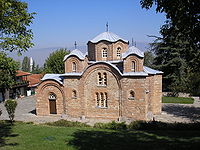 The Church of St. Panteleimon has five domes in a quincunx pattern.
The Church of St. Panteleimon has five domes in a quincunx pattern.
In this period, domes were normally built to emphasize separate functional spaces, rather than as the modular ceiling units they had been earlier.[39] Resting domes on circular or polygonal drums pierced with windows eventually became the standard style, with regional characteristics.[34] The domes of the Church of the Holy Apostles appear to have been radically altered between 944 and 985 by the addition of windowed drums beneath all five domes and by raising the central dome higher than the others.[42] The distinctive rippling eaves design for the roofs of domes begins in the 10th century. In mainland Greece, circular or octagonal drums became the most common while, in Constantinople, drums with twelve or fourteen sides were popular beginning in the 11th century.[34]
The domed-octagon plan is a variant of the cross-in-square plan.[41] The earliest extant example is the katholikon at the monastery of Hosios Loukas, built in the first half of the 11th century. Its square crossing bay is defined by four L-shaped piers which transition by conical squinches to an octagonal drum for the 9 meter wide dome.[38] The smaller monastic church at Daphni, c. 1080, uses a simpler version of this plan.[34]
Another variant of the cross-in-square, the "so-called atrophied Greek cross plan", also provides greater support than the typical cross-in-square by using piers set securely into the corners of the square naos. This design was used in the Chora Church of Constantinople in the 12th century after the previous cross-in-square structure was destroyed by an earthquake.[39]
Byzantine domes typically incorporated wooden tension rings at several levels within the structure, a technique frequently attributed as the later invention of Filippo Brunelleschi. Metal clamps between stone cornice blocks, metal tie rods, and metal chains were also used to stabilize domed construction.[39] The technique of using double shells for domes, although revived in the Renaissance, originated in Byzantine practice.[43]
Byzantine domes and techniques of religious architecture spread to the surrounding Christian nations, such as Georgia and Armenia. Armenian church domes were initially wooden structures. Etchmiadzin Cathedral (c. 483) originally had a wooden dome covered by a wooden pyramidal roof before this was replaced with stone construction in 618. Churches with stone domes became the standard type after the 7th century, perhaps benefiting from a possible exodus of stonecutters from Syria, but the long traditions of wooden construction carried over stylistically. Some examples in stone as late as the 12th century are detailed imitations of clearly wooden prototypes.[10]
Arabic and Western-European domes
 The Dome of the Rock in Jerusalem
The Dome of the Rock in Jerusalem
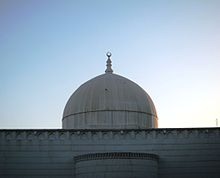 Dome of Al Othman Mosque in Hawalli, Kuwait
Dome of Al Othman Mosque in Hawalli, Kuwait
Seventeen years after the last Western Roman Emperor was deposed, Theodoric the Great was the Ostrogothic king of Italy. His building projects largely continued existing architectural conventions. His Arian Baptistry in Ravenna (c. 500), for example, closely echoes the Baptistry of Neon built before it.[44] Both baptistries are octagonal buildings with pyramidal roofs concealing interior domes.
The Mausoleum of Theodoric, however, was understood by contemporaries to be remarkable.[44] Begun in 520, the 36-foot-wide (11 m) dome over the mausoleum was carved out of a single 440 ton slab of limestone and positioned some time between 522 and 526. The twelve brackets carved as part of the dome's exterior are thought to have been used to maneuver the piece into place. The choice of large limestone blocks for the structure is significant as the most common construction material in the West at that time was brick. It is likely that foreign artisans were brought to Ravenna to build the structure; possibly from Syria, where such stonework was used in contemporary buildings.[45]
The Syria and Palestine area has a long tradition of domical architecture, including wooden domes in shapes described as "conoid", or similar to pine cones. When the Arab Muslim forces conquered the region, they employed local craftsmen for their buildings and, by the end of the 7th century, the dome had begun to become an architectural symbol of Islam. The rapidity of this adoption was likely aided by the Arab religious traditions, which predate Islam, of both domed structures to cover the burial places of ancestors and the use of a round tabernacle tent with a dome-like top made of red leather for housing idols.[10]
The Dome of the Rock in Jerusalem, the earliest surviving Islamic building, was completed in 691 by Umayyad caliph Abd Al-Malik.[46] Its design was that of a ciborium, or reliquary, such as those common to Byzantine martyria and the major Christian churches of the city.[47] The dome, a double shell design made of wood, is 20.44 meters in diameter and 30 meters high.[48] It is currently covered in gilded aluminum. Several restorations since 1958 to address structural damage have resulted in the extensive replacement of tiles, mosaics, ceilings, and walls such that "nearly everything that one sees in this marvelous building was put there in the second half of the twentieth century", but without significant change to its original form and structure.[49]
Byzantine workmen built the Umayyad Mosque of Damascus and its hemispherical dome for Sherif al Walid in 705. The dome rests upon an octagonal base formed by squinches.[23]
Italian church architecture from the late sixth century to the end of the eighth century is influenced less by the trends of Constantinople than by a variety of Eastern provincial plans. With the crowning of Charlemagne as a new Roman Emperor, these influences were largely replaced in a revival of earlier Western building traditions. Occasional exceptions include examples of early quincunx churches at Milan and near Cassino.[34]
Charlemagne built the Palatine Chapel at his palace at Aachen between 789 and its consecration in 805. The architect is thought to be Odo of Metz, although the quality of the ashlar construction has led to speculation about the work of outside masons.[50] The chapel's domed octagon design was influenced by Byzantine models such as the Basilica of San Vitale in Ravenna, the Church of Sergius and Bacchus in Constantinople, and perhaps the Chrysotriklinos, or "golden reception hall", of the Great Palace of Constantinople.[50][51] The octagonal domical vault measures 16.5 meters wide and 38 meters high. It was the largest dome north of the Alps at that time.[52]
The dome of the Great Mosque of Kairouan (also called the Mosque of Uqba) built in the first half of the 9th century, has a ribbed hemispherical dome which rests on an octogonal drum with slightly concave sides.[53][54]
The Great Mosque of Córdoba, begun in 785 under the last of the Umayyad caliphs, was enlarged by Al-Hakam II between 961 and 976 to include four domes and a remodeled mihrab. The central dome, in front of the mihrab area, transitions from a square bay with decorative squinches to eight overlapping and intersecting arches which surround and support a scalloped dome.[37]
Southern Italy, Sicily, and Venice served as outposts of Middle Byzantine architectural influence in Italy. That southern Italy was reconquered and ruled by a Byzantine governor from about 970 to 1071 explains the relatively large number of small and rustic Middle Byzantine-style churches found there, including the Cattolica in Stilo and S. Marco in Rossano. Both are cross-in-square churches with five small domes on drums in a quincunx pattern and date either to the period of Byzantine rule or after. The church architecture of Sicily has fewer examples, having been conquered by Muslims in 827, but quincunx churches exist with single domes on tall central drums with either Byzantine pendentives or Islamic squinches.[34] Very little architecture from the Islamic period survives on the island. The domed basilicas built in Sicily after the Norman Conquest of 1091, however, incorporate distinctly Islamic architectural elements. They include hemispherical domes positioned directly in front of apses, similar to the common positioning in mosques of domes directly in front of mihrabs, and the domes use squinches supported on four points, as do the domes of Islamic North Africa and Egypt. In other cases, domes with tall drums, engaged columns, and blind arcades exhibit Byzantine influences.[55]
Venice's close mercantile links to the Byzantine empire resulted in the architecture of that city and its vicinity being a blend of Byzantine and northern Italian influences, although nothing from the ninth and tenth centuries has survived except for the foundations of the first St. Mark's Basilica.[34] The current St Mark's Basilica was built between 1063 and 1072, replacing an earlier church while replicating its Greek cross plan. Five domes vault the interior (one each over the four arms of the cross and one in the center). These domes were built in the Byzantine style, in imitation of the now lost Church of the Holy Apostles in Constantinople. Mounted over pendentives, each dome has a ring of windows at its base. Much higher wooden outer domes with lead roofing and cupolas were added between 1210 and 1270, allowing the church to be seen from a great distance.[56] In addition to allowing for a more imposing exterior, building two distinct shells in a dome improved weather protection. However, it was a rare practice before the 11th century.[33]
Domes in Romanesque architecture are generally found within crossing towers at the intersection of a church's nave and transept, which conceal the domes externally. The precise form of these differ from region to region.[37] Romanesque domes are typically octagonal in plan, possibly due to their use of corner squinches to translate a square bay into a suitable octagonal base.[4] They appear "in connection with basilicas almost throughout Europe" between 1050 and 1100.[57]
Being a part of the Holy Roman Empire, the architecture of northern Italy developed differently than the rest of the Italian peninsula, especially after 1100. Churches were designed with vaulting from the outset, rather than as colonnaded basilicas with timber roofs, and many have octagonal domes with squinches over their crossings or choirs.[58]
The earliest use of the octagonal cloister vault within an external housing at the crossing of a cruciform church may be at Acqui Cathedral in Acqui Terme, Italy, which was completed in 1067. This becomes increasingly popular as a Romanesque feature over the course of the next fifty years. The first Lombard church to have a lantern tower, concealing an octagonal cloister vault, was San Nazaro in Milan, just after 1075. Many other churches followed suit in the next few decades, such as the Basilica of San Michele Maggiore in Pavia and the Basilica of Sant'Ambrogio in Milan.[59]
Pisa Cathedral, built between 1063 and 1118, includes a high elliptical dome at the crossing of its nave and transept. The dome was one of the first in Romanesque architecture and is considered the masterpiece of Romanesque domes. Rising 48 meters above a rectangular bay, the shape of the dome was unique at the time.[60] The rectangular bay's dimensions are 18 meters by 13.5 meters. Squinches were used at the corners to create an elongated octagon and corbelling used to create an oval base for the dome. The tambour on which the dome rests dates to between 1090 and 1100, and it is likely that the dome itself was built at this time. There is evidence that the builders did not originally plan for the dome and decided on the novel shape to accommodate the rectangular crossing bay, which would make an octagonal cloister vault very difficult. Additionally, the dome may have originally been covered by a lantern tower which was removed in the 1300s, exposing the dome, to reduce weight on foundations not designed to support it. This would have been done no later than 1383, when the Gothic loggetta on the exterior of the dome was added, along with the buttressing arches on which it rests.[59]
An aspiring competitor to Pisa, the city of Florence took the opposite side in the conflict between Pope and Emperor, siding with the Pope in Rome. This was reflected architecturally in the "proto-renaissance" style of its buildings.[58] The eight-sided Florence Baptistery, with its large octagonal cloister vault beneath a pyramidal roof, was likely built between 1059 and 1128, with the dome and attic built between 1090 and 1128. The lantern above the dome is dated to 1150.[61] It takes inspiration from the Pantheon in Rome for its oculus and much of its interior decoration, although the pointed dome is structurally similar to other Lombard domes, such as that of the later Cremona Baptistery.[59]
The renovation of Speyer Cathedral, the largest of the Imperial Cathedrals of the Holy Roman Empire and the burial church of the Salian dynasty, by the Emperor Henry IV, was begun around 1080, soon after Henry had returned from a trip to Canossa in northern Italy. Although the church had only just been consecrated in 1061, Henry called upon craftsmen from across the empire for its renovation. The redesign included two octagonal cloister vaults within crossing towers, one at the east crossing with an external dwarf gallery and one at the west end. This was very soon imitated elsewhere and became the model for later Rhenish octagonal crossing domes, such as those of Worms Cathedral (c. 1120 - 1181) and Mainz Cathedral (c. 1081 - 1239).[58]
The Crusades, beginning in 1095, also appear to have had an impact on domed architecture in Western Europe, particularly in the areas around the Mediterranean Sea.[62] The Dome of the Rock and the Al-Aqsa Mosque on the Temple Mount of Jerusalem were taken to represent the Temple of Solomon and the Palace of Solomon, respectively. The Knights Templar, headquartered at the site, built a series of centrally-planned churches throughout Europe modeled on the Church of the Holy Sepulchre, with the Dome of the Rock also an influence.[63]
Medieval churches in southwest France at Solignac, Souillac, and Périgueux have five domes in a cruciform arrangement similar to that of St. Mark's Basilica. Dozens of other Romanesque churches in the region have a single nave with domed roofs.[60] The earliest may be Angoulême Cathedral, built from 1105 to 1128. Its long nave is covered by four stone domes on pendentives, springing from French pointed arches, the last of which covers the crossing and is surmounted by a stone lantern.[64][65] Cahors Cathedral (c.1100-1119) covers its nave with two large domes in the same manner and influenced the later building at Souillac. The cathedral of S. Front at Périgueux was built c. 1125-1150.[65] The use of pendentives to support domes in this region is a possible indication of close cultural links to the Byzantine Empire.[4] There are also examples of French Romanesque churches with oval plan domes, such as the churches at Saint-Martin-de-Gurson, Dordogne and Balzac, Charente.[66]
During the Reconquista, the Kingdom of León in northern Spain built three churches famous for their domed crossing towers, called "cimborios", as it acquired new territories. The Cathedral of Zamora, the Cathedral of Salamanca, and the collegiate church of Toro were built around the middle of the 12th century. All three buildings have stone umbrella domes with sixteen ribs over windowed drums of either one or two stories, springing from pendentives. All three also have four small round towers engaged externally to the drums of the domes on their diagonal sides.[58] The architectural influences at work here have been much debated, with proposed origins ranging from Jerusalem, Islamic Spain, the Limousin region in western France, or a mixture of sources.[37]
Another unusual Spanish example from the late 12th or early 13th century is the dome of The Church of the Holy Sepulchre in Torres Del Río, on the Way of St. James. The Way, a major pilgrimage route through northern Spain to the reputed burial place of St. James the Greater, attracted pilgrims from throughout Europe, especially after pilgrimage to Jerusalem was cut off. The difficulty of travel to Jerusalem for pilgrimage prompted some new churches to be built as a form of substitute, evoking the central plan and dome of Jerusalem's Church of the Holy Sepulchre with their own variant. The dome in this case, however, is most evocative of the central mihrab dome of the Great Mosque of Cordoba. Over an octagonal room, the stone dome is formed by sixteen ribs, eight of which intersect with one another in a star pattern to define a smaller octagon at the center of the dome.[37]
The domed "Decagon" nave of St. Gereon's Basilica in Cologne, Germany, a ten-sided space in an oval shape, was built between 1219 and 1227 upon the remaining low walls of a 4th century Roman martyrium.[67] The ribbed dome rises four stories and 34.55 meters above the floor, covering an oval area 21 meters long and 16.9 meters wide. It is unique among the twelve Romanesque churches of Cologne, and in European architecture in general, and may have been the largest dome built in this period in Western Europe until the completion of the dome of Florence Cathedral.[68][69]
Gothic domes are uncommon due to the use of ribbed vaulting, and with the crossing usually focused instead by a tall steeple, but there are examples of small octagonal domes at cathedral crossings as the style developed from Romanesque.[37] Spaces of circular or octagonal plan were sometimes covered with vaults of a "double chevet" style, similar to the chevet apse vaulting in Gothic cathedrals. The crossing of Saint Nicholas at Blois is an example.[70] Timber star vaults such as those over York Minster's octagonal Chapter house (ca. 1286-1296) and the elongated octagon plan of Wells Cathedral's Lady Chapel (ca.1320-1340) imitated much heavier stone vaulting.[37] The wooden vaulting over the crossing of Ely Cathedral in England was built after the original crossing tower collapsed in 1322. It was conceived by Alan of Walsingham and designed by master carpenter William Hurley.[71][72] Eight hammer vaults extend from eight piers over the 22 meter wide octagonal crossing and meet at the base of a large octagonal lantern, which is covered by a star vault.[58]
Star-shaped domes are also found at the Moorish palace of the Alhambra in Granada, Spain, which contains domed audience halls built to mirror the heavenly constellations. The Hall of the Abencerrajes (c. 1333-1391) and the Hall of the two Sisters (c. 1333-1354) are extraordinarily developed examples of muqarnas domes, taking the tradition of the squinch in Islamic architecture from a functional element in the zone of transition to a highly ornamental covering for the dome itself. The structural elements of these two domes are actually brick vaulting, but these are completely covered by the intricate mocárabe stalactites. The lacy and star-shaped crossing dome of Burgos Cathedral (1567) may have been inspired by these examples, in addition to that built over the cathedral's octagonal Chapel of the Condestable (1482–94) in the Gothic style.[37]
If an external lantern tower was removed from Pisa Cathedral in the 1300s, exposing the dome, one reason may have been to stay current with more recent projects in the region, such as the domed cathedrals of Siena and Florence. The dome of Siena Cathedral had an exposed profile as early as 1224.[59] Set over an irregular 17.7 meter wide hexagon with squinches to form an irregular twelve-sided base, the dome of Siena Cathedral has two shells and was completed in 1264.[73] No large dome had ever before been built over a hexagonal crossing.[74] The dome was originally topped with a copper orb, similar to that over Pisa's dome today, but this was replaced in 1385 by a cupola surmounted by a smaller sphere and cross.[75] The current lantern dates from the 17th century and the current outer dome is a 19th century replacement.[76] Rapid progress on a radical expansion of the cathedral which would have involved replacing the existing dome with a larger one was halted not long after the city was struck with an outbreak of the Black Death in 1348.[74]
It was only a few years after the city of Siena had decided to abandon the massive expansion and redesign of their Cathedral in 1355 that Florence decided to greatly expand theirs.[74] A plan for the dome of Florence Cathedral was settled by 1357.[59] However, in 1368 the plan was altered at the east end to increase the scale of the octagonal dome, widening it from 62 to 72 braccia, with the intent to surpass the domes of Pisa and Siena.[71] The scale of this new dome was so ambitious that experts for the Opera del Duomo, the board supervising the construction, expressed the opinion as early as 1394 that the dome could not be accomplished.[77] The enlarged dome would span the entire 42 meter width of the three aisled nave, just 2 meters less than that of the Roman Pantheon, the largest dome in the world.[58] And because the distance between the angles of the octagonal dome were even farther apart at 45.5 meters, the average span would be marginally wider.[33] At 144 braccia, the height of the dome would evoke the holy number of the Heavenly Jerusalem mentioned in the Book of Revelation. By 1413, with the exception of one of the three apses, the east end of the church had been completed up to the windowed octagonal drum but the problem of building the huge dome did not yet have a solution.[58] In 1417, the master builder in charge of the project retired and a competition for dome designs was begun in August of 1418.[78]
Persian and Timurid domes
 The Shah Mosque, Iran. When completed in 1629, this mosque took the role of conducting the Friday- prayers.
The Shah Mosque, Iran. When completed in 1629, this mosque took the role of conducting the Friday- prayers.
Persian Sassanid architecture likely inherited an architectural tradition of dome-building dating back to the earliest Mesopotamian domes.[23]
Ruins of the Palace of Ardashir and Ghal'eh Dokhtar in Fars Province, built by Ardashir I (224 - 240), demonstrate the use of the dome by the Sassanid Empire in what is today Iran. The structures have the earliest known examples of the Persian use of conical squinches to transition from a square room to the circular base of a dome. The large brick dome of the Sarvestan Palace, also in Fars but later in date, shows more elaborate decoration and four windows between the corner squinches. The building may have been a Fire temple, many of which had a central domed chamber.[79] Such Zoroastrian fire temples, square domed buildings with entrances at the axes, inspired the forms of early mosques after the Islamic conquest of the empire.[37]
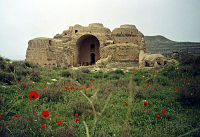 The Palace of Ardashir, constructed in AD 224. The building is compromised of three large domes.
The Palace of Ardashir, constructed in AD 224. The building is compromised of three large domes.
During the early Islamic period, domed mausolea contributed greatly to the development and spread of the dome in Persia. By the 10th century, domed tombs had been built for Abbasid caliphs and Shiite martyrs. Pilgrimage to these sites may have helped to spread the form. The Samanid Mausoleum in Transoxiana dates to no later than 943 and is the first to have squinches create a regular octagon as a base for the dome, which then became the standard practice. The Arab-Ata Mausoleum, also in Transoxiana, may be dated to 977-78 and uses muqarnas between the squinches for a more unified transition to the dome. Cylindrical or polygonal plan tower tombs with conical roofs over domes also exist beginning in the 11th century.[79] The earliest known masonry double shell domes are those of a pair of brick tower tombs from the 11th century in Kharraqan, Iran. The domes may have been modeled on earlier wooden double shell domes, such as that of the Dome of the Rock. It is also possible, because the upper portions of both of the outer shells are missing, that some portion of the outer domes may have been wooden.[33] These brick mausoleum domes were built without the use of centering, a technique developed in Persia.[78]
The Il-Khanate period provided several innovations to dome-building that eventually enabled the Persians to construct much taller structures. These changes later paved the way for Safavid architecture. The taller proportions resulted primarily from the increased height of the zone of transition, with the addition of a sixteen-sided section above the main zone of muqarnas squinches.[79] The pinnacle of Il-Khanate architecture was reached with the construction of the Mausoleum of Öljaitü (1302–1312) in Zanjan, Iran, which is topped by a dome that measures 50 m in height and 25 m in diameter, making it the 3rd largest and tallest masonry dome ever erected.[80] The thin, double-shelled dome was reinforced by arches between the layers.[79]
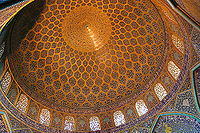 Interior view of the Lotfallah Mosque in Iran (finished in 1618). It was a private mosque of the royal court of the Safavids.
Interior view of the Lotfallah Mosque in Iran (finished in 1618). It was a private mosque of the royal court of the Safavids.
The renaissance in Persian mosque and dome building came during the Safavid dynasty, when Shah Abbas, in 1598 initiated the reconstruction of Isfahan, with the Naqsh-e Jahan Square as the centerpiece of his new capital.[81] Architecturally, they borrowed heavily from Il-Khanate designs, but artistically, they elevated the designs to a new level. The distinct feature of Persian domes, which separates them from those domes constructed in the Christian world or the Ottoman and Mughal empires, was the colorful tiles, with which they covered the exterior of their domes, as they would on the interior. These domes soon numbered dozens in Isfahan, and the distinct, blue- colored shape would dominate the skyline of the city. Reflecting the light of the sun, these domes appeared like glittering turquoise gem and could be seen from miles away by travelers following the Silk road through Persia. This very distinct style of architecture was inherited to them from the Seljuq dynasty, who for centuries had used it in their mosque building throughout Central-Asia, but it was perfected during the Safavids when they invented the haft- rangi, or seven- colour style of tile burning, a process that enabled them to apply more colours to each tile, creating richer patterns, sweeter to the eye.[82] The colours that the Persians favoured where golden, white and turquoise patterns on a dark- blue background.[83] The extensive inscription bands of calligraphy and arabesque on most of the major buildings where carefully planned and executed by Ali Reza Abbasi, who was appointed head of the royal library and Master calligrapher at the Shah's court in 1598,[84] while Shaykh Bahai oversaw the construction projects. Reaching at total height of 53 meters, and with a diameter of 25 m at the base of the dome, the dome of Masjed-e Shah (Shah Mosque) would become the largest in the city when it was finished in 1629. It was built as a double- shelled dome, with 14 m spanning between the two layers, and resting on a sixteen-sided dome-chamber.[85][86]
The Il-Khanate legacy also laid the groundwork for a separate brand of architectural style, the Timurid Islamic architecture, which later also became an inspiration to Mughal architects. During the 14th and 15th century, Timur and his successors adorned Samarkand and other Central-Asian cities with spectacular and stately edifices. The Sanctuary of Ahmed Yasawi, situated in southern Kazakhstan was never finished, but has got the largest existing brick dome in Central Asia, measuring 18.2 m in diameter. The dome exterior is covered with hexagonal green glazed tiles with gold patterns.[87]
Russian domes
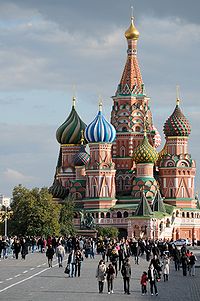 Saint Basil's Cathedral (1555 - 1561) in Moscow, Russia. Its distinctive onion domes date to the 1680s.
Saint Basil's Cathedral (1555 - 1561) in Moscow, Russia. Its distinctive onion domes date to the 1680s.
The multidomed church is a typical form of Russian church architecture, which distinguishes Russia from other Orthodox nations and Christian denominations. Indeed, the earliest Russian churches, built just after the Christianization of Kievan Rus', were multi-domed, which has led some historians to speculate about how Russian pre-Christian pagan temples might have looked. Examples of these early churches are the 13-domed wooden Saint Sophia Cathedral in Novgorod (989) and the 25-domed stone Desyatinnaya Church in Kiev (989-996). The number of domes typically has a symbolical meaning in Russian architecture, for example 13 domes symbolize Christ with 12 Apostles, while 25 domes means the same with an additional 12 Prophets of the Old Testament. The multiple domes of Russian churches were often comparatively smaller than Byzantine domes.[88][89]
The earliest stone churches in Russia featured Byzantine style domes, however by the Early Modern era the onion dome had become the predominant form in traditional Russian architecture. The onion dome is a dome whose shape resembles an onion, after which they are named. Such domes are often larger in diameter than the drum upon which they are set, and their height usually exceeds their width. The whole bulbous structure tapers smoothly to a point. Though the earliest preserved Russian domes of such type date from the 16th century, illustrations from older chronicles indicate that they were at least used since the late 13th century. Like tented roofs, which were combined with and sometimes replaced domes in Russian architecture since the 16th century, onion domes initially were used only in wooden churches and were introduced into stone architecture much later, where their carcasses continued to be made either of wood or metal on top of masonry drums.[90]
Russian domes are often gilded or brightly painted. A dangerous technique of chemical gilding using mercury had been applied on some occasions until the mid-19th century, most notably in the giant dome of Saint Isaac's Cathedral. The more modern and safe method of gold electroplating was applied for the first time in gilding the domes of the Cathedral of Christ the Saviour in Moscow, the tallest Eastern Orthodox church in the world.[91]
Italian Renaissance and Ottoman domes
After years of considering options, Filippo Brunelleschi and Lorenzo Ghiberti were made joint leaders of the project to build the dome for Florence Cathedral in 1420. Brunelleschi's plan to use suspended scaffolding for the workers won out over alternatives such as building a provisional stone support column in the center of the crossing or filling the space with earth. The octagonal brick domical vault was built between 1420 and 1436, with Ghiberti resigning in 1433. The lantern surmounting the dome, also designed by Brunelleschi, was not begun until 1446, after his death. It was completed in 1467. He had also planned for a two-story external gallery and cornice to be built at the top of the drum where a strip of unclad masonry can be seen today. Although a portion of it was constructed on the southeast side beginning in 1508, work stopped after the visual effect was criticized by Michelangelo. The dome is 42 meters wide and made of two shells.[58] A stairway winds between them. Eight white stone external ribs mark the edges of the eight sides, next to the red tile roofing, and extend from the base of the dome to the base of the cupola. Each of the eight sides of the dome also conceal a pair of intermediate stone ribs which are connected to the main ribs by means of a series of masonry rings. A temporary wooden tension ring still exists near the bottom of the dome. Three horizontal chains of sandstone blocks notched together and reinforced with lead-coated iron cramps also extend the entire circumference of the dome: one at the base (where radial struts from this chain protrude to the exterior), one a third of the way up the dome, and one two thirds of the way up the dome.[78] It was the largest dome built in Western Europe since the Pantheon, and remains the largest masonry dome ever built.
Brunelleschi's plan for the dome of the Pazzi Chapel in Florence's Basilica of Santa Croce (1430–1452) illustrates the Renaissance enthusiasm for geometry and for the circle as geometry's supreme form. Twelve ribs between twelve circular windows converge on a small oculus. The circular dome rests on pendentives decorated with circular medallions of Florentine ceramic. This emphasis on geometric essentials would be very influential. The dome of San Sisto in Piacenza (1499–1514) is likewise circular and also includes pendentives with circular medallions.[37]
Among the Renaissance domes with a ribbed or spoked wheel design include that of the Certosa di Pavia (1396–1473) and the Madonna di Campagna in Piacenza (1522–1528).[37]
The first church with an oval dome in the Renaissance period was the Sant'Andrea in Via Flaminia, built from 1550 to 1554 by Vignola. The transverse section of the dome is a semi-oval and the longitudinal section is a semicircle. Julius III commissioned the dome.[92] Use of the oval dome subsequently spread quickly through Italy, Spain, France, and central Europe.[66]
Süleymaniye Mosque, built in Constantinople (modern Istanbul) from 1550 to 1557, has a main dome 53 meters high with a diameter of 26.5 meters. At the time it was built, the dome was the highest in the Ottoman Empire when measured from sea level, but lower from the floor of the building and smaller in diameter than that of the nearby Hagia Sophia.
The Selimiye Mosque in the city of Edirne, Turkey, was the first structure built by the Ottomans which had a larger dome than that of the Hagia Sophia. The dome sits on an octagonal base and has an internal diameter of 31.25 meters. Designed and built by architect Mimar Sinan between 1568 and 1574, when he finished it he was 86 years old, and he considered the mosque to be his masterpiece.
The double shell dome of St. Peter's Basilica was completed in 1590. Slightly smaller in diameter than those of the Pantheon and Florence Cathedral, the inner dome is hemispherical, while the outer ribbed dome is vertically oval. The outside of the drum is decorated with pairs of columns between the large windows. Its internal diameter is 41.47 meters (136.1 ft) and its external height from the ground to the top of the cross is 136.57 meters (448.1 ft). The dome remains the tallest in the world. The style of the church ushered in what would become known as Baroque architecture, and the dome in particular would have great influence on subsequent designs.
South-Asian and Mughal domes
Another distinctive sub-style is the architecture of the Mughal Empire in South Asia in the 16th century and a fusion of Arabic, and Persian elements. Considered the finest example of Mughal architecture, the Taj Mahal is a mausoleum which combines elements of Persian, Indian, and Islamic architecture. Its large marble dome, often called an onion dome or amrud (guava dome), is about 35 meters high and sits on a cylindrical drum about 7 meters high. The Taj Mahal, the "teardrop on eternity," was completed in 1648 by emperor Shah Jahan in memory of his wife Mumtaz Mahal. The extensive use of precious and semiprecious stones as inlay and the vast quantity of white marble required nearly bankrupted the empire. The Taj Mahal is completely symmetric except for Shah Jahan's sarcophagus, which is placed off center in the crypt room below the main floor. This symmetry extended to the building of an entire mirror mosque in red sandstone to complement the Mecca-facing mosque place to the west of the main structure.
The Badshahi Mosque in Pakistan remained the largest mosque ever built until the Grand Mosque in Mecca was constructed in 1986. It has three domes, the largest of which is the central one which reaches 15 m in height and has a diameter of 21.5 m at the central bulging.
The non-Mughal Gol Gumbaz in the Deccan, however, retained the claim to being the largest dome in India and in fact the second largest in the world. The internal diameter of the hemispherical dome is 124 feet and it rises 175 feet above the floor over a square chamber 135 feet wide.[23]
Early modern period domes
St. Paul's Cathedral in London was rebuilt from 1677 to 1708. The crossing dome, designed in several stages by Sir Christopher Wren, had its initiation with the first plans for modifying Old St. Paul's, even before the fire of 1666. It was the first church dome ever raised in England: "a form of church building," John Evelyn recorded in his diary,[93] "not as yet known in England, but of wonderful grace." When finished, the dome was three layers: an inner dome with an oculus, a decorative outer wood dome covered in lead roofing, and a structural brick cone in between. The brick cone ends in a small dome, which supports the cupola and outer roof and the decorated underside of which can be seen through the inner dome's oculus. It rises 365 feet (108 m) to the cross at its summit, but is evocative of the much smaller Tempietto by Bramante.[94]
Adjacent to a hospital and retirement home for injured war veterans, the royal chapel of Les Invalides in Paris, France, was begun in 1679 and completed in 1708. The dome was one of many inspired by that of St. Peter's Basilica and it is an outstanding example of French Baroque architecture. In 1861 the body of Napoleon Bonaparte was moved from St. Helena to the most prominent location under the dome.
The Sanctuary of Vicoforte in northwest Italy was originally meant to be the official dynastic mausoleum of the Savoia family, which had governed Piedmont and southwest France since the 15th century, but problems with uneven settlement due to the soil led to a halt in construction and the mausoleum was built elsewhere. After efforts of compensate for the settlement, construction was resumed to complete the building as a basilica. The oval dome, very close to an ellipse, was completed in 1731 and is the largest masonry dome of its kind in the world. It measures 37.15 meters by 24.8 meters at its base and is pierced by eight oval windows and a central oval oculus with a cupola. Although iron rings were used as part of the original construction at three levels to hold the dome together, cracks developed in the dome as the foundation settled further over the centuries. Additional reinforcement was added from 1985-1987 to halt their spread.[95]
Modern period domes
New production techniques allowed for cast iron and wrought iron to be produced both in larger quantities and at relatively low prices during the Industrial Revolution. Iron was used in place of wood where fire resistance was a priority. In Russia, which had large supplies of iron, some of the earliest examples of the material's architectural use can be found. Andrey Voronikhin built a large wrought iron dome over Kazan Cathedral in Saint Petersburg.[96] Built between 1806 and 1811, the 17.7 meter wide outer dome of the cathedral was one of the earliest iron domes.[97]
Although iron production in France lagged behind Britain, the government was eager to foster the development of its domestic iron industry. In 1808, the government of Napoleon approved a plan to replace the burnt down wooden dome of the Halle au Blé granary in Paris with a dome of iron and glass, the "earliest example of metal with glass in a dome". The dome was 37 meters in diameter and used 51 cast iron ribs to converge on a wrought iron compression ring 11 meters wide containing a glass and wrought iron skylight. The outer surface of the dome was covered with copper, with additional windows cut near the dome's base to admit more light during an 1838 modification.[96]
An early example from Britain is the fanciful iron-framed dome over the central building of the Royal Pavilion in Brighton, begun in 1815 by John Nash, the personal architect of King George IV.[96]
In 1828, the eastern crossing tower of Mainz Cathedral was rebuilt by Georg Moller with a wrought iron dome.[96]
Saint Isaac's Cathedral, in Saint Petersburg, was built by 1842 with one of the largest domes in Europe. A cast iron dome nearly 26 meters wide, it had a technically advanced triple-shell design with iron trusses reminiscent of St. Paul's Cathedral in London.[96]
The Neoclassical style popular at this time was challenged in the middle of the nineteenth century by a Gothic Revival in architecture, in what has been termed the "Battle of the Styles". This lasted from about 1840 to the beginning of the twentieth century, with various styles within Classicism, such as Renaissance, Baroque, and Rococo revivals, also vying for popularity. The last three decades of this period included unusual combinations of these styles.[98]
The current dome over the United States Capitol building, although painted white and crowning a masonry building, is also made of cast iron. The dome was built between 1855 to 1866, replacing a lower wooden dome with copper roofing from 1824.[99] It was completed just two years after the Old St. Louis County Courthouse, which has the first cast iron dome built in the United States.[100] The initial design of the capitol dome was influenced by a number of European church domes, particularly St. Paul's in London, St. Peter's in Rome, the Panthéon in Paris, Les Invalides in Paris, and St. Isaac’s Cathedral in St. Petersburg.[101] The architect, Thomas U. Walter, designed a double dome interior based on that of the Panthéon in Paris.[99]
The British Museum Library constructed a new reading room in the courtyard of its museum building between 1854 and 1857. The round room, about 42.6 meters in diameter and inspired by the Pantheon, was surmounted by a dome with a ring of windows at the base and an oculus at the top. Hidden iron framing supported a suspended ceiling made of papier-mâché.[102] Inspired by the prestigious British Museum reading room, the first iron dome in Canada was built in the early 1870s over the reading room of the Library of Parliament building in Ottawa. Unlike the British Museum room, the library, which opened in 1876, uses the Gothic style.[103] The dome of the Thomas Jefferson Building of the Library of Congress, also inspired by the reading room dome at the British Museum, was built between 1889 and 1897 in a classical style. It is 100 feet wide and rises 195 feet above the floor on eight piers. The dome has a relatively low external profile to avoid overshadowing the nearby United States Capitol dome.[104]
The Hungarian Parliament Building was built in the Gothic style, although most of the 1882 design competition entries used Neo-Renaissance, and it includes a domed central hall. The large, ribbed, egg-shaped dome topped with a spire was influenced by the dome of the Maria vom Siege church in Vienna.[105] It has a sixteen sided outer shell with an iron skeleton that rises 96 meters high, and an inner shell star vault supported on sixteen stone pillars. The Dome Hall is used to display the coronation crown of Hungary and statuary of monarchs and statesmen. The dome was structurally complete by the end of 1895.[106]
The large domes of the 19th century also included hothouses, winter gardens, arcades, and exhibition buildings, as well as functional structures such as gasometers and locomotive sheds.[107] Excluding those metal domes which simply imitated multi-shell masonry, metal framed domes such as the elliptical dome of Royal Albert Hall (57 to 67 meters in diameter) in London and the circular dome of Halle au Blé in Paris may represent the chief 19th century development of the simple domed form.[33]
The final development of the masonry dome may have been the work of the Guastavino family, who perfected a traditional Spanish and Italian technique for light, center-less vaulting using layers of tiles in fast-setting cement set flat against the surface of the curve, rather than perpendicular to it. The father and son team worked on the eastern seaboard of the United States in the late 19th and early 20th centuries. The father, Rafael Guastavino, innovated with the use of Portland cement as the mortar, rather than the traditional lime and gypsum mortars, which allowed mild steel bar to be used to counteract tension forces.[33] The family built vaults in hundreds of buildings, including the domes of the Basilica of St. Lawrence in Asheville, North Carolina, and St. Francis de Sales Roman Catholic Church in Philadelphia, Pennsylvania.[108] The dome over the crossing of the Cathedral of St. John the Divine in New York City was built by the son in 1909. A part-spherical dome, it measures 30 meters in diameter from the top of its merging pendentives, where steel rods embedded in concrete act as a restraining ring. With an average thickness 1/250th of its span, and steel rods also embedded within the pendentives, the dome "looked forward to modern shell construction in reinforced concrete."[33]
The thin domical shell was further developed with the construction of two domes in Jena, Germany in the early 1920s. To build a rigid planetarium dome, Walther Bauersfeld constructed a triangulated frame of light steel bars and mesh with a domed formwork suspended below it. By spraying a thin layer of concrete onto both the formwork and the frame, he created a 16 meter wide dome that was just 30 millimeters thick. The second dome was still thinner at 40 meters wide and 60 millimeters thick.[33] These are considered the first geodesic domes. The term was coined later by Buckminster Fuller, who invented them independently and received a patent in 1954. Geodesic domes have been used for radar enclosures, greenhouses, housing, and weather stations. The U.S. Pavilion at Expo 67 in Montreal, Canada, was enclosed by a 76.5 meter wide and 60 meter tall dome made of steel pipes and acrylic panels. It is used today as a water monitoring center.[52]
In the 20th century, thin "eggshell" domes of pre-stressed concrete by architect-engineers such as Pier Luigi Nervi opened new directions in fluid vaulted spaces enclosed beneath freeform domed space which now might be supported merely at points rather than in the traditional constricting ring.
Tensegrity domes, patented by Buckminster Fuller in 1962, are fabric-covered structures consisting of radial trusses made from steel cables under tension with vertical steel pipes spreading the cables into the truss form. They have been made circular, elliptical, and other shapes to cover stadiums from Korea to Florida.[109]
Many sports stadiums are domed, especially in climates that have widely variable summer and winter weather. The first such stadium was the Astrodome in Houston, Texas.
While the first permanent domed membrane structures were the radar domes designed and built by Walter Bird after World War II, the cable-restrained and air-supported tension membrane structure designed by David Geiger to cover the United States pavilion at Expo '70 was a landmark construction. Its low expense led to the development of permanent versions using teflon-coated fiberglass and within 15 years the majority of the domed stadiums around the world used this system, including the Silverdome in Pontiac, Michigan.[110]
A major improvement to the domed stadium was accomplished with the construction of SkyDome, now Rogers Centre, in Toronto, Ontario, the first domed stadium with a retractable roof.
Symbolism
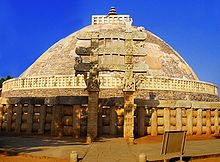 The 'Great Stupa' at Sanchi in India, built in the 3rd century BCE.
The 'Great Stupa' at Sanchi in India, built in the 3rd century BCE.
According to E. Baldwin Smith, from the late Stone Age the dome-shaped tomb was used as a reproduction of the ancestral, god-given shelter made permanent as a venerated home of the dead. The instinctive desire to do this resulted in widespread domical mortuary traditions across the ancient world, from the stupas of India to the tholos tombs of Iberia. By Hellenistic and Roman times, the domical tholos had become the customary cemetery symbol.[10]
In the process of transforming the hut shape from its original pliable materials into more difficult stone construction, the dome had also become associated with celestial and cosmic significance, as evident from decoration such as stars and celestial chariots on the ceilings of domed tombs. This cosmological thinking was not limited to domed ceilings, being part of a symbolic association between any house, tomb, or sanctuary and the universe as a whole, but it popularized the use of the domical shape.[10]
A distinct symbolism of the heavenly or cosmic tent stemming from the royal audience tents of Achaemenid and Indian rulers was adopted by Roman rulers in imitation of Alexander the Great, becoming the imperial baldachin. This probably began with Nero, whose "Golden House" also made the dome an essential feature of palace architecture.[10]
The Christian use of domes acknowledged these symbolic associations. The traditional mortuary symbolism led the dome to be used in Christian central-type martyria in the Syrian area, the growing popularity of which spread the form. The spread and popularity of the cult of relics also transformed the domed central-type martyria into the domed churches of mainstream Christianity. In Italy in the 4th century, baptisteries began to be built like domed mausolea and martyria, which spread in the 5th century. This reinforced the theological emphasis on baptism as a re-experience of the death and resurrection of Jesus Christ. The dual sepulchral and heavenly symbolism was adopted by early Christians in both the use of domes in architecture and in the ciborium, a domical canopy like the baldachin used as a ritual covering for relics or the church alter. The celestial symbolism of the dome, however, was the preeminent one by the Christian era.[10]
Literary evidence exists that the idea of the cosmic temple had been applied to the Christian basilica by the end of the 4th century, in the form of a speech by Eusebius on a church in Tyre. However, it is only in the mid 6th century that the earliest literary evidence of a cosmological interpretation of a domed church building exists, in the form of a hymn composed for the cathedral church of Edessa. Kathleen E. McVey traces this to a blending by Jacob of Serugh of the two major but contradictory schools of biblical exegesis at the time: the building-as-microcosm tradition of the Antioch school combined with the Alexandrian view of the cosmos and firmament as composed of spheres and hemispheres, which was rejected by the Antioch school.[111]
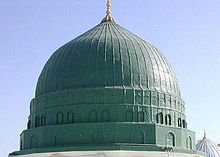 The Green Dome built above the tomb of Muhammad, Abu Bakr and Umar in the Al-Masjid al-Nabawi (Prophet's Mosque) in Medina, Saudi Arabia, dates back to at least the 12th century.
The Green Dome built above the tomb of Muhammad, Abu Bakr and Umar in the Al-Masjid al-Nabawi (Prophet's Mosque) in Medina, Saudi Arabia, dates back to at least the 12th century.
Otto Demus writes that Middle Byzantine churches were decorated in a systematic manner and can be seen as having three zones of decoration, with the holiest at the top. This uppermost zone contained the dome, drum and apse. The dome was reserved for an image of Christ called the "Pantokrator" (meaning "ruler of all"), usually as a bust in a roundrel, the drum usually contained images of angels or prophets, and the semi-dome of the apse usually depicted the Virgin Mary, typically holding the Christ child and flanked by angels.[39]
According to Oleg Grabar, the domes of the Islamic world, which rejected such imagery, continued the other traditions. Muslim royalty built palatial pleasure domes in continuation of the Roman and Persian imperial models, although many have not survived, and domed mausoleums from Merv to India developed the form.[112] In the early centuries of Islam, domes were closely associated with royalty. A dome built in front of the mihrab of a mosque, for example, was at least initially meant to emphasize the place of a prince during royal ceremonies. Over time such domes became primarily focal points for decoration or the direction of prayer. The use of domes in mausoleums can likewise reflect royal patronage or be seen as representing the honor and prestige which domes symbolized, rather than having any specific funerary meaning.[113]
Oleg Grabar characterizes forms in Islamic architecture as having relatively low levels of symbolism. While conceding this in a general sense, Yasser Tabbaa maintains that certain forms were initially very highly symbolic and only lost such associations over time. The phenomenon of muqarnas domes, in particular, is an example. Tabbaa explains the development and spread of muqarnas domes throughout the Islamic world beginning in the early 11th century as the visual expression of a theological idea of the universe propounded by the Ash'arites (a modification of the Atomism of Aristotle with Occasionalism), which rose to prominence in Baghdad at this time. Only later was the style used in a purely decorative manner.[114]
Influential domes
Domes that have been disproportionately influential in later architecture are those of the Pantheon in Rome, Hagia Sophia in Constantinople (modern Istanbul), and the Dome of the Rock in Jerusalem. In Western architecture, the most influential domes built after the early Renaissance exploit of Brunelleschi's Florentine dome have been those of St. Peter's Basilica in Rome and Jules Hardouin-Mansart's dome at Les Invalides in Paris. The dome of St. Paul's Cathedral in London was the inspiration for the United States Capitol in Washington, which in turn inspired domes of most of the US state capitols.
General types
Onion dome
Main article: Onion domeThe onion dome or bulbous dome is a bulbous shape tapering smoothly to a point, strongly resembling an onion, after which they are named, and exemplified by Saint Basil's Cathedral in Moscow and the Taj Mahal. They are found mostly in eastern architecture, particularly in Russia, Turkey, India, and the Middle East. An onion dome is a type of architectural dome usually associated with Russian Orthodox churches. Such a dome is larger in diameter than the drum it is set upon and its height usually exceeds its width. It is also a common feature among Catholic churches in the south of Germany, Austria, and Switzerland.
Bulbous domes became popular in the second half of the 15th century in the Low Countries of Northern Europe, possibly inspired by the finials of minarets in Egypt and Syria. They were developed in the 16th and 17th centuries in Holland before spreading to Germany, becoming a popular element of the baroque architecture of Central Europe. German bulbous domes were also influenced by Russian and Eastern European examples.[115]
Corbel dome
A corbel dome is different from a 'true dome' in that it consists of purely horizontal layers. As the layers get higher, each is slightly cantilevered, or corbeled, toward the center until meeting at the top. A famous example is the Mycenaean Treasury of Atreus.
Geodesic dome
Main article: Geodesic domeGeodesic domes are the upper portion of geodesic spheres. They are composed of a framework of triangles in a polyhedron pattern.[52]
Oval dome
An oval dome is a dome of oval shape in either plan or profile or both. The term comes from the Latin ovum, meaning "egg". Although oval domes have been dated at least as far back as the Middle Ages, many Renaissance and Baroque domes are of this type, notably those of Bernini and Borromini.[66] The largest oval dome was built in the basilica of Vicoforte by Francesco Gallo.
Parabolic dome
A parabolic dome is a unique structure, in which bending stress due to the UDL of its dead load is zero. Hence it was widely used in buildings in ancient times, before the advent of composite structures. However if a point load is applied on the apex of a parabolic dome, the bending stress becomes infinite. Hence it is found in most ancient structures, the apex of the dome is stiffened or the shape modified to avoid the infinite stress.
Polygonal dome
Main article: Cloister vaultCalled domical vaults, cloister vaults, or coved vaults, these are domes which maintain a polygonal shape in their horizontal cross section. The most famous example is the Renaissance octagonal dome of Filippo Brunelleschi over the Florence Cathedral. Thomas Jefferson, the third president of the United States, installed an octagonal dome above the West front of his plantation house, Monticello.[116]
Sail dome
Also called sail vaults, pendentive domes, or Byzantine domes, this type can be thought of as pendentives which, rather than merely touching each other to form a circular base for a drum or compound dome, smoothly continue their curvature to form the dome itself. The dome gives the impression of a square sail pinned down at each corner and billowing upward.
Saucer dome
A saucer dome is the architectural term used for a low pitched shallow dome which is described geometrically as having a circular base and a segmental (less than a semicircle) section. A section across the longer axis results in a low dome, capping the volume. A very low dome is a saucer dome. Many of the largest existing domes are of this shape.
Gaining in popularity from the 18th century onwards, the saucer dome is often a feature of interior design. When viewed from below it resembles the shallow concave shape of a saucer. The dome itself, being often contained in the space between ceiling and attic, may be invisible externally. These domes are usually decorated internally by ornate plaster-work, occasionally they are frescoed.
They are seen occasionally externally in Byzantine churches and Ottoman mosques. Most of the mosques in India, Pakistan, Iran and Afghanistan have these type of domes.
Umbrella dome
Also called pumpkin, melon, scalloped, or parachute domes, these are a type of dome segmented by ribs radiating from the center of the dome to the base. The material between the ribs arches from one to the other, transferring the downward force to them. The central dome of the Hagia Sophia uses this method, allowing a ring of windows to be placed between the ribs at the base of the dome. The central dome of St. Peter's Basilica also uses this method.
See also
- Vault (architecture)
- Geodesic dome
- Monolithic dome
- List of celebrated domes
- List of world's largest domes
- List of Domes in France
- Gonbad
References
- ^ Rasch, Jürgen (1985). "Die Kuppel in der römischen Architektur. Entwicklung, Formgebung, Konstruktion". Architectura 15: 117–139 (117)
- ^ a b c d Nuttgens, Patrick. The Story of Architecture. Phaidon Press Limited. Hong Kong. 1997. ISBN 0-7148-3616-8
- ^ a b The Catholic Encyclopedia. New Advent. Retrieved October 26, 2010.
- ^ a b c Fletcher, Sir Banister, and Dan Cruickshank (Ed.). Sir Banister Fletcher's A History of Architecture. 20th ed, illustrated, reprint. Architectural Press, 1996. ISBN 978-0-7506-2267-7.
- ^ Hitchcock, Don. Don's Maps. "Mezhirich - Mammoth Camp". Retrieved August 15, 2009.
- ^ Palmer, Douglas, Paul Pettitt and Paul G. Bahn. Unearthing the past: the great archaeological discoveries that have changed history. Globe Pequot, 2005. Illustrated edition. ISBN 978-1-59228-718-5.
- ^ "Forest Foragers: A Day in the Life of Efe Pygmies in the Democratic Republic of Congo". (April 9, 2010). Cultural Survival Quarterly. Retrieved December 7, 2010.
- ^ Crandall, David P. The Place of Stunted Ironwood Trees: A Year in the Lives of the Cattle-herding Himba of Namibia, (page 34-35) Continuum International Publishing Group, 2000. 269 pages. ISBN 978-0-8264-1270-6
- ^ Hill, Donald Routledge. A history of engineering in classical and medieval times. Psychology Press, 1996. Illustrated edition, reprint. ISBN 978-0-415-15291-4.
- ^ a b c d e f g h i j k l m Smith, Earl Baldwin. The Dome: A Study in the History of Ideas. Princeton University Press, 1950. ISBN 0-691-03875-9.
- ^ Delougaz, P., A. Alizadeh and H.J. Kantor. 1996. Chogha Mish: the first five seasons of excavations 1961-1971. Oriental Institute of the University of Chicago, Chicago.
- ^ YouTube - IRAN: Seven Faces of a Civilization- Part 1
- ^ Leick, Gwendolyn. A dictionary of ancient Near Eastern architecture (page 202) Routledge, 1988
- ^ Kawami, Trudy S. "Parthian brick vaults in Mesopotamia, their antecedents and decendants". Journal of the Ancient Near Eastern Society (The), 1982.
- ^ Chant, Colin, David C. Goodman and Open University. Pre-industrial cities & technology. Psychology Press, 1999. illustrated edition. ISBN 978-0-415-20076-9.
- ^ Kubba, Shamil A. A. "Mesopotamian architecture and town planning from the Mesolithic to the end of the Proto-historic Period c. 10,000-3,500 B.C."[1][2] University of Michigan: B.A.R., 1987.
- ^ Arnold, Dieter. "Cupola". The Encyclopaedia of Ancient Egyptian Architecture. Helen Strudwick and Nigel Strudwick (Eds.). I.B.Tauris, 2003. ISBN 978-1-860-64465-8.
- ^ Tombs cast light on nation's origins. The National. Updated February 20, 2010. Retrieved on January 2, 2011.
- ^ Abu Dhabi Authority for Culture and Heritage (ADACH). Jebel Hafit Tombs. Retrieved on January 2, 2011.
- ^ Paner, Henryk and Zbigniew Borcowski. "Dome graves and other uncommon constructions from the Fourth Cataract region". Proceedings of the Second International Conference on the Archaeology of the Fourth Nile Cataract, Berlin, August 4th - 6th, 2005. Volume 23 of Meroitica (Wiesbaden). Edited by Claudia Näser Mathias Lange. Otto Harrassowitz Verlag, 2007. ISBN 978-3-447-05680-9.
- ^ McNeil, Ian. An Encyclopaedia of the history of technology. Taylor & Francis, 1990. Illustrated edition, reprint. ISBN 978-0-415-01306-2.
- ^ Gwendolyn Leick: A Dictionary of Ancient Near Eastern Architecture, London and New York 2003, p. 64 ISBN 978-0-203-19965-7
- ^ a b c d e Chisholm, Hugh. The Encyclopædia Britannica: a dictionary of arts, sciences ..., Volume 27 (page 957) At the University press, 1911
- ^ a b c d e f g h i Lehmann, Karl (1945). "The Dome of Heaven". In W. Eugène Kleinbauer (Ed.), Modern Perspectives in Western Art History: An Anthology of Twentieth-Century Writings on the Visual Arts, pp. 227 - 270. Volume 25 of Medieval Academy Reprints for Teaching. University of Toronto Press, 1989. 528 pages.
- ^ Kosso, Cynthia, and Anne Scott (Eds.). The nature and function of water, baths, bathing, and hygiene from antiquity through the Renaissance. BRILL, 2009. 978-9-004-17357-6.
- ^ a b c d e Lancaster, Lynne C. Concrete vaulted construction in Imperial Rome: innovations in context. illustrated ed. Cambridge University Press, 2005. 274 pages. ISBN 978-0-521-84202-0
- ^ a b Mark, Robert and Paul Hutchinson. "On the Structure of the Roman Pantheon". College Art Association. The Art Bulletin. Vol. 68, No. 1 (March 1986), pp. 24-34.
- ^ a b Conti, Cinzia, Giangiacomo Martines and Anna Sinopoli. "Constructions Techniques of Roman Vaults: Opus Caementicium and the Octagonal Dome of the Domus Aurea". Proceedings of the Third International Congress on Construction History, Cottbus, May 2009.
- ^ Aïtcin, Pierre-Claude. Binders for Durable and Sustainable Concrete. Psychology Press, 2008. Illustrated edition. ISBN 978-0-415-38588-6.
- ^ a b c Sear, Frank. Roman Architecture. Cornell Paperbacks. Cornell University Press, illustrated, revised ed. 1983. 288 pages. ISBN 978-0-8014-9245-7
- ^ The Roman Pantheon: The Triumph of Concrete
- ^ Johnson, Mark J. The Roman Imperial Mausoleum in Late Antiquity. Cambridge University Press. 1st ed. 2009. 330 pages. ISBN 978-0-521-51371-5
- ^ a b c d e f g h i j k Mainstone, Rowland J. Developments in structural form. Architectural Press, 2001. 2nd edition, illustrated (reprint). ISBN 978-0-7506-5451-7.
- ^ a b c d e f g h i j k Krautheimer, Richard. Early Christian and Byzantine Architecture. Yale University Press, 1992. 4th edition, illustrated. 553 pages. ISBN 978-0-300-05294-7
- ^ a b c d Freely, John and Ahmet S. Çakmak. Byzantine Monuments of Istanbul. Cambridge University Press. New York. 2004. ISBN 0-521-77257-5.
- ^ Ring, Trudy, Robert M. Salkin and Sharon La Boda. International Dictionary of Historic Places: Southern Europe. Taylor & Francis, 1996. Illustrated edition. ISBN 978-1-884964-02-2.
- ^ a b c d e f g h i j k l Stephenson, Davis, Victoria Hammond and Keith F. Davi. Visions of Heaven: the Dome in European Architecture. Princeton Architectural Press, 2005. Illustrated edition. ISBN 978-1-56898-549-7.
- ^ a b c Anderson, Stanford; Wilson, Colin St. John & Goode, Patrick (Ed.). The Oxford companion to architecture, Volume 1. Oxford University Press, 2009. ISBN 978-0-19-860568-3
- ^ a b c d e f Ousterhout, Robert G. Master Builders of Byzantium. UPenn Museum of Archaeology, 2008. ISBN 978-1-934536-03-2.
- ^ Ousterhout, Robert G. (1998). "Reconstructing Ninth-Century Constantinople". In Leslie Brubaker (Ed.), Ninth Century Constantinople, Dead or Alive?, pp. 115-130. Hampshire: Ashgate.
- ^ a b Darling, Janina K. Architecture of Greece. Greenwood Publishing Group, 2004. ISBN 978-0-313-32152-8.
- ^ Beckwith, John. Early Christian and Byzantine art. Yale University Press, 1993. 2nd edition, illustrated; reprint. ISBN 978-0-300-05296-1.
- ^ Wittkower, Rudolf (1963). "S. Maria della Salute: Scenographic Architecture and the Venetian Baroque". In W. Eugène Kleinbauer (Ed.), Modern Perspectives in Western Art History: An Anthology of Twentieth-Century Writings on the Visual Arts, pp. 165 - 192. Volume 25 of Medieval Academy Reprints for Teaching. University of Toronto Press, 1989. 528 pages.
- ^ a b Barnish, S. J. B. The Ostrogoths from the migration period to the sixth century: an ethnographic perspective. Center for Interdisciplinary Research on Social Stress. Boydell & Brewer Ltd, 2007. Illustrated edition. ISBN 978-1-84383-074-0.
- ^ Belcari, Riccardo and Giulia Marrucchi (2007). Art of the Middle Ages. New York: Barnes & Noble, Inc. p. 56. ISBN 978-0-7607-8887-5.
- ^ Murphy-O'Connor, Jerome. The Holy Land: an Oxford archaeological guide from earliest times to 1700. Oxford University Press US, 2008. 5th edition, illustrated. ISBN 978-0-19-923666-4.
- ^ Hoffman, Eva Rose F. Late antique and medieval art of the Mediterranean world. Wiley-Blackwell, 2007. Illustrated edition. ISBN 978-1-4051-2071-5.
- ^ Gibb, Sir H. A. R. The Encyclopaedia of Islam, Volume 2, Part 1. Brill Archive.
- ^ Grabar, Oleg. The Dome of the Rock. Harvard University Press, 2006. Illustrated edition. ISBN 978-0-674-02313-0.
- ^ a b Dupré, Judith. Churches. HarperCollins, 2001. Illustrated edition. ISBN 978-0-06-019438-3.
- ^ Bullough, Donald A. Carolingian renewal: sources and heritage. Manchester University Press ND, 1991. ISBN 978-0-7190-3354-4.
- ^ a b c Langmead, Donald, and Christine Garnaut. Encyclopedia of architectural and engineering feats. ABC-CLIO, 2001. 3rd edition, illustrated. ISBN 978-1-57607-112-0.
- ^ Paul Sebag, The Great Mosque of Kairouan, Collier-Macmillan, 1965, pages. 75-85
- ^ Georges Marçais, Coupole et plafonds de la Grande Mosquée de Kairouan 1925, pages. 8-11
- ^ Nicklies, Charles E. Builders, Patrons, and Identity: The Domed Basilicas of Sicily and Calabria. International Center of Medieval Art. Gesta, Vol. 43, No. 2 (2004), pp. 99-114.
- ^ Fregonese, Luigi, and Laura Taffurelli. 3D Model for the documentation of cultural heritage: the wooden domes of St. Mark's Basilica in Venice. Politecnico di Milano, Best, Italy. Retrieved January 1, 2011.
- ^ Porter, Arthur Kingsley. Spanish Romanesque sculpture. The University of Virginia: Hacker Art Books, 1969. Illustrated edition (reprint). Digitized May 25, 2010.
- ^ a b c d e f g h Schütz, Bernhard. Great Cathedrals. Harry N. Abrams, Inc., 2002. ISBN 0-8109-3297-0.
- ^ a b c d e Smith, Christine. "East or West in 11th-Century Pisan Culture: The Dome of the Cathedral and Its Western Counterparts". Journal of the Society of Architectural Historians(University of California Press) 43 (3):195-208.
- ^ a b Fossi, Gloria (2008). Romanesque & Gothic. Sterling Publishing Company, Inc. Illustrated ed. 192 pages. ISBN 978-1-4027-5924-6
- ^ Horn, Walter. "Romanesque Churches in Florence: A Study in Their Chronology and Stylistic Development". The Art Bulletin. Vol. 25, No. 2 (Jun., 1943), pp. 112-131.
- ^ Jeffery, George. A Brief Description of the Holy Sepulchre Jerusalem and Other Christian Churches in the Holy City: With Some Account of the Mediaeval Copies of the Holy Sepulchre Surviving in Europe. Cambridge University Press, 2010 (first published in 1919). ISBN 978-1-108-01604-9.
- ^ Howard, Deborah. Venice and Islam in the Middle Ages: Some Observations on the Question of Architectural Influence. Architectural History, Vol. 34 (1991), pp. 59-74.
- ^ Browne, Edith A. Romanesque Architecture. Kessinger Publishing, 2005. ISBN 978-1-4179-5420-9.
- ^ a b Watkin, David. A history of Western architecture Laurence King Publishing, 2005. 4th edition, illustrated. ISBN 978-1-85669-459-9.
- ^ a b c Huerta, Santigo (2007). "Oval domes: History, geometry and mechanics". Nexus Network Journal 9(2), 211-248.
- ^ Nussbaum, Norbert. German Gothic Church architecture. Yale University Press, 2000. Illustrated edition. ISBN 978-0-300-08321-7.
- ^ Hayes, Holly (2009-12-15). "St. Gereon Church, Cologne". Sacred Destinations. Retrieved 2011-01-14.
- ^ Schmitz, Marie-Theres. Irish arts review, Volumes 2-3. Eton Enterprises, 1985. page 49.[3][4]
- ^ Ward, Clarence. Mediaeval Church Vaulting. Princeton University Press, 1915. Illustrated edition, reprint. ISBN 978-0-404-06836-3.
- ^ a b Frankl, Paul and Paul Crossley. Gothic Architecture. Yale University Press, 2000. Revised, illustrated edition. ISBN 978-0-300-08799-4.
- ^ Pepin, David. Discovering Cathedrals. Osprey Publishing, 2008. 7th edition, illustrated. ISBN 978-0-7478-0597-7.
- ^ Salvan, George S. Architectural character & the history of architecture. Goodwill Trading Co., Inc., 2005. 3rd edition. ISBN 978-971-12-0262-0.
- ^ a b c Norman, Diana. Siena, Florence, and Padua: Case studies. Yale University Press, 1995. Illustrated edition. ISBN 978-0-300-06126-0.
- ^ Carli, Enzo. Siena Cathedral and the Cathedral Museum. The University of Michegan. Scala, 2003. 95 pages.
- ^ Bartoli, Gianni, et. al. In situ testing and structural assessment of an historic masonry dome.. Retrieved November 28, 2010.
- ^ Salvadori, Mario, Saralinda Hooker, and Christopher Ragus. Why buildings stand up: the strength of architecture. W. W. Norton & Company, 1990. Illustrated edition; reprint. ISBN 978-0-393-30676-7.
- ^ a b c Gentry, T. Russell, and Anatoliusz "Tolek" Lesniewski. Structural Design and Construction of Brunelleschi's Duomo di Santa Maria del Fiore. Eleventh North American Masonry Conference (NAMC). Minneapolis, Minnesota. June 5–8, 2011.
- ^ a b c d O'Kane, Bernard (1995). Domes. Encyclopaedia Iranica, Online Edition. Retrieved November 28, 2010.
- ^ http://www.iranreview.org/content/view/2280/51/
- ^ Savory, Roger; Iran under the Safavids, p. 155
- ^ Blake, Stephen P.; Half the World, The Social Architecture of Safavid Isfahan, 1590- 1722, p. 143- 144
- ^ Canby, Sheila R.; Shah Abbas, The Remaking of Iran, p. 30.
- ^ Canby, Sheila R.; Shah Abbas, The Remaking of Iran, p. 36.
- ^ Hattstein M., Delius P.; Islam, Art and Architecture; p. 513- 514
- ^ http://archnet.org/library/sites/one-site.jsp?site_id=2306
- ^ "Architectural complex of Khodja Akhmed Yasawi". http://www.natcom.unesco.kz/turkestan/e10_mausoleum.htm. Retrieved 2009-09-16.
- ^ Russian Church Design by Lisa Kies.
- ^ About Russian Domes and Cupolas at Sky Palace world architecture site.
- ^ The shapes of domes of ancient Russian churches by Sergey Zagraevsky at the site of RusArch.ru (Russian)
- ^ The history of galvanotechnology in Russia (Russian)
- ^ http://roma.katolsk.no/andreavignola.htm[dead link]
- ^ Evelyn, Diary 28 August 1666, noted by John Summerson, "The mind of Wren" reprinted in Heavenly Mansions, 1963:72.
- ^ Millers, Keith. St. Peter's. Harvard University Press, 2007 (page 61)
- ^ Aoki, Takayoshi, Mario Alberto Chiorino and Roberto Roccati. "Structural characteristics of the elliptical masonry dome of the sanctuary of Vicoforte". Proceedings of the First International Congress on Construction History, Madrid, 20th-24th January 2003, ed. S. Huerta, Madrid: I. Juan de Herrera, SEdHC, ETSAM, A. E. Benvenuto, COAM, F. Dragados, 2003.
- ^ a b c d e Gayle, Margot, and Carol Gayle. Cast-iron architecture in America: the significance of James Bogardus. W. W. Norton & Company, 1998. Illustrated edition. 272 pages. ISBN 978-0-393-73015-9.
- ^ Skempton, A. W. A biographical dictionary of civil engineers in Great Britain and Ireland: 1500-1830. Thomas Telford, 2002. illustrated edition. 897 pages. ISBN 978-0-727-72939-2
- ^ Miller, Judith, and Tim Clinch. Classic Style. Simon and Schuster, 1998. Illustrated edition. ISBN 978-0-684-84997-3.
- ^ a b "The United States Capitol Dome". Architect of the Capitol. Retrieved November 28, 2010.
- ^ Condit, Carl W. American building: materials and techniques from the first colonial settlements to the present. Volume 25 of Chicago history of American civilization. University of Chicago Press, 1968. 2nd edition. 329 pages.
- ^ Allen, William C. History of the United States Capitol: A chronicle of design, construction, and politics. Government Printing Office, 2001. 498 pages.
- ^ British Museum - Reading Room. British Museum. Retrieved 2011-10-13.
- ^ Young, Carolyn Ann. The Glory of Ottawa: Canada's First Parliament Buildings. McGill-Queen's Press - MQUP, 1995. illustrated edition. 204 pages. ISBN 978-0-773-51227-6.
- ^ Cole, John Young and Henry Hope Reed. Herbert Small (ed.) The Library of Congress: the art and architecture of the Thomas Jefferson Building. W. W. Norton & Company, 1997. Illustrated edition. 320 pages. ISBN 978-0-393-04563-5.
- ^ Moravánszky, Ákos . Competing visions: aesthetic invention and social imagination in Central European architecture, 1867-1918. MIT Press, 1998. Illustrated edition. ISBN 978-0-262-13334-0.
- ^ Villám, Judit, Dániel Szabó, György Gyarmati, István Soltész, and József Sisa. Zsuzsa Boronkay-Roe (trans.) The Hungarian National Assembly. Budapest, 2006.
- ^ Kohlmaier, Georg and Barna Von Sartory. John C. Harvey (trans.) Houses of Glass: a Nineteenth-Century Building Type. MIT Press, 1991. Reprint, illustrated edition. 652 pages. ISBN 978-0-262-61070-4.
- ^ Ochsendork, John, and Michael Freeman. Guastavino Vaulting: The Art of Structural Tile. Princeton Architectural Press, 2010. Illustrated edition. ISBN 978-1-56898-741-5.
- ^ Levy, Matthys, and Mario Salvadori. Why buildings fall down: how structures fail. W. W. Norton & Company, 2002. Illustrated edition; reprint. ISBN 978-0-393-31152-5.
- ^ Bradshaw, Richard, David Campbell, Mousa Gargari, Amir Mirmiran, and Patrick Tripeny. Special Structures: Past, Present, and Future. Journal of Structural Engineering. June 2002. DOI: 10.1061/(ASCE)0733-9445(2002)128:6(691)
- ^ McVey, Kathleen E. "The Domed Church as Microcosm: Literary Roots of an Architectural Symbol". Dumbarton Oaks Papers, Vol. 37 (1983), pp. 91-121.
- ^ Grabar, Oleg. From Dome of Heaven to Pleasure Dome. Journal of the Society of Architectural Historians, Vol. 49, No. 1 (Mar., 1990), pp. 15-21. University of California Press.
- ^ Grabar, Oleg. The Islamic Dome, Some Considerations. Journal of the Society of Architectural Historians, Vol. 22, No. 4 (Dec., 1963), pp. 191-198.
- ^ Tabbaa, Yasser. "The Muqarnas Dome: Its Origin and Meaning". Muqarnas, Vol. 3 (1985), pp. 61-74.
- ^ Born, Wolfgang. The Introduction of the Bulbous Dome into Gothic Architecture and Its Subsequent Development. Speculum, Vol. 19, No. 2. (Apr., 1944), pp. 208-221.
- ^ Kern, Chris. "Jefferson's Dome at Monticello". http://www.ChrisKern.Net/essay/jeffersonsDomeAtMonticello.html. Retrieved 2009-07-14.
Gallery
-
The exterior of the dome of Selimiye Mosque in Edirne.
-
Dome of the former Church of Saints Sergius and Bacchus(today mosque of Little Hagia Sophia) in Istanbul.
-
Interior of the dome, San Francisco City Hall.
-
Interior of St. Joseph the Betrothed Ukrainian Greek Catholic Church in Chicago, Illinois depicting Christ Pantocrator as in traditional byzantine church style.
-
The interior dome of the Santa Maria del Fiore in Florence designed by Brunelleschi it was completed in 1436.
-
Interior of the Old St. Louis Courthouse dome.
-
Lotfallah Mosque in Isfahan, Iran.
-
Dome of the Rotunda of the Church of the Holy Sepulchre, Jerusalem.
-
The mihrab dome (9th century) of the Great Mosque of Kairouan, located in the city of Kairouan in Tunisia.
-
Ottoman domes in the Balkans.
Categories:- Domes
- Arches and vaults
- Architectural elements
- Ancient Roman architectural elements
- Byzantine architecture
- Ancient Near East art and architecture
- Church architecture
- Mosque architecture
- Baroque architectural features
- Ceilings
- Roofs
Wikimedia Foundation. 2010.

